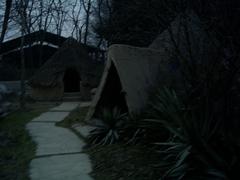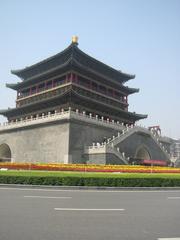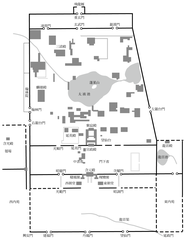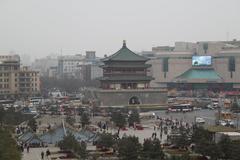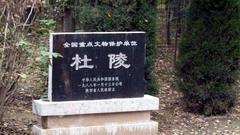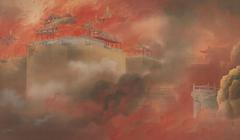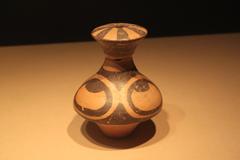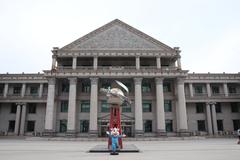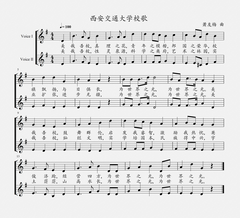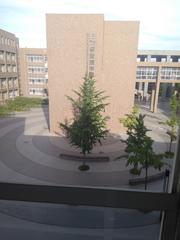Daxuexixiang Mosque: Visiting Hours, Tickets, and Attractions – Xi’an Historical Sites Guide
Date: 04/07/2025
Introduction
Nestled within the heart of Xi’an’s historic Muslim Quarter, the Daxuexixiang Mosque—also known as the Great Mosque of Xi’an or West Great Mosque—is a remarkable symbol of over a millennium of cultural integration and religious devotion. Established during the Tang Dynasty around 705 AD, the mosque stands as one of China’s oldest Islamic sites, reflecting Xi’an’s pivotal role as the eastern terminus of the Silk Road and as a melting pot of diverse cultures and faiths (Xi’an Deep Tour; chinatripedia.com).
Unlike many mosques worldwide, Daxuexixiang Mosque uniquely blends traditional Chinese architectural elements—timber-framed structures, curved tiled roofs, and a courtyard layout—with Islamic religious features such as Arabic calligraphy and geometric motifs. This architectural fusion is a testament to centuries of harmonious coexistence between Chinese and Islamic cultures, embodied by the Hui Muslim community who have used the mosque as a spiritual, educational, and social center (Kuwait Journals; youlinmagazine.com).
Beyond its architectural beauty, the mosque preserves historical narratives through bilingual steles and inscriptions, chronicling its evolution through dynastic patronage, wars, and periods of religious suppression. Today, it remains an active place of worship and a cultural landmark welcoming visitors interested in Xi’an’s multicultural heritage.
This comprehensive guide provides practical information for planning your visit, including visiting hours, ticket policies, accessibility, and tips for exploring nearby attractions. Whether you are a history enthusiast, architectural admirer, or cultural traveler, this resource will enrich your experience at Daxuexixiang Mosque—an enduring symbol of East-West cultural dialogue and religious tradition (TravelUrChina; China Highlights).
Table of Contents
- Historical Background
- Architectural Features and Cultural Synthesis
- Historical Challenges and Preservation
- Visiting Information
- Dress Code and Etiquette
- Photography Guidelines
- Visitor Tips
- Frequently Asked Questions (FAQ)
- Conclusion
- References
Historical Background
Early Foundations and Tang Dynasty Origins
The Daxuexixiang Mosque was established during the Shenlong period of the Tang Dynasty, around 705 AD (Xi’an Deep Tour). This era marked the height of Chang’an’s (modern Xi’an) prominence as the eastern terminus of the Silk Road, attracting traders and scholars from Central Asia, Persia, and the Arab world. The arrival of Islam in China is traced to the mid-7th century, leading to the growth of the local Muslim community and the establishment of mosques such as Daxuexixiang (TravelUrChina).
Architectural Evolution and Dynastic Patronage
The mosque’s Tang Dynasty foundations are evident in its timber structures, curved roofs, and traditional courtyard layout—hallmarks of Chinese architecture blended with Islamic tradition (Kuwait Journals). Over centuries, successive dynasties including the Yuan, Ming, and Qing expanded and renovated the mosque, each leaving distinctive decorative elements, inscriptions, and prayer halls. Imperial support, especially during the Ming and Qing periods, helped preserve and enhance the mosque, commemorated in its steles and plaques (Xi’an Deep Tour).
Role in the Hui Muslim Community
As one of Xi’an’s three major ancient mosques, Daxuexixiang Mosque has served as a religious, educational, and social hub for the Hui Muslim community. It fostered Islamic scholarship, with facilities for Quranic studies, Arabic language instruction, and Islamic jurisprudence (Xi’an Deep Tour). Today, the mosque continues to be a center for worship and cultural activities.
Architectural Features and Cultural Synthesis
Daxuexixiang Mosque is celebrated for its unique architectural fusion—merging Chinese and Islamic elements in a harmonious and distinctive style.
- Courtyard Layout: The mosque is organized along a central axis, featuring multiple courtyards that transition from the bustling urban environment to tranquil, sacred spaces. This layout mirrors the classic Chinese “siheyuan” pattern (Academia.edu).
- Timber Structures and Curved Roofs: Timber framing, upturned eaves, and tiled roofs are adapted for Islamic religious use, with prayer halls oriented towards Mecca.
- Phoenix Pavilion (Minaret): Instead of a traditional minaret, a pagoda-style tower marks the entrance, decorated with intricate wooden carvings (Pilgrimaps).
- Decorative Carvings: Wood and brick carvings feature floral and animal motifs alongside Quranic inscriptions (Xi’an Deep Tour).
- Steles and Inscriptions: Bilingual steles in Chinese and Arabic document the mosque’s history and community contributions (Islamic China).
- Materials and Construction: Traditional mortise-and-tenon joints and bracket sets (dougong) allow for the mosque’s curved roofs and wide eaves (Academia.edu).
Historical Challenges and Preservation
Daxuexixiang Mosque has survived numerous historical upheavals, including wars and the Cultural Revolution (1966–1976), during which many religious sites were destroyed (Wikipedia). Its designation as a protected cultural site in 1956 and later as a Major National Historical Site in 1988 secured its ongoing preservation (Xi’an Deep Tour). Restoration projects have maintained its architectural integrity and accessibility for future generations.
Visiting Information
Visiting Hours
- General Hours: 8:00 AM to 6:00 PM daily (China Highlights). Some sources note extended hours to 9:00 PM, especially during peak tourist seasons (China Discovery). Check local listings or official sources for updates.
Ticket Prices and Entry Policies
- Tourists: Entrance fee ranges from ¥15 (off-season, December–February) to ¥25 (peak season, March–November). Cash is required (China Discovery).
- Worshippers: Free entry.
- Guidebook: Complimentary upon ticket purchase, available in Chinese and English.
Guided Tours and Special Events
- Guided Tours: Available via local agencies or onsite, often in Mandarin and English, providing historical and architectural insights.
- Special Events: The mosque hosts religious festivals and cultural events during Ramadan and Eid; these are open to visitors and offer unique cultural experiences (travelsetu.com).
Accessibility
- Public Transport: Nearest metro is Beidajie Station (Line 2), followed by a short walk. The area is pedestrian-friendly with nearby bus stops.
- Mobility: Main courtyards and prayer hall are accessible, but some traditional structures may have limited wheelchair access due to steps or uneven paving.
How to Get There
- By Foot: 10–20 minutes’ walk from the Bell Tower through the Muslim Quarter (China Highlights).
- By Vehicle: No direct parking; plan for a 10–20 minute walk from the nearest lot.
Nearby Attractions
- Bell Tower: 300 meters from the mosque, offering panoramic views (China Highlights).
- Drum Tower: Another iconic Xi’an landmark.
- Muslim Quarter: Famous for its vibrant markets and street food.
- Gaojiadayuan Residence: Offers shadow puppet performances.
- Other Mosques: Huajue Alley and Xiaopi Alley mosques.
Dress Code and Etiquette
- Modest Dress: Arms and legs should be covered; loose-fitting clothing is recommended. Women are encouraged (but not required) to cover their hair (Blue Mosque; China Highlights).
- Shoes: Remove shoes before entering prayer areas.
- Behavior: Speak quietly, avoid eating, drinking, or smoking inside the complex, and respect all signage and staff instructions.
Photography Guidelines
- Outdoor Areas: Photography is permitted in courtyards and gardens (China Discovery).
- Restricted Areas: No photography inside the main prayer hall or in worship areas.
- People: Always ask permission before photographing local worshippers or staff.
Visitor Tips
- Best Times: Early morning or late afternoon for fewer crowds and softer lighting.
- Shopping: Bargain when buying souvenirs in the Muslim Quarter (China Highlights).
- Food: Try local Hui specialties like lamb skewers and roujiamo from family-run stalls.
- Guided Experience: Seek out onsite guides or audio tours for deeper understanding.
Frequently Asked Questions (FAQ)
Q: What are the mosque’s visiting hours?
A: Open daily from 8:00 AM to 6:00 PM (may extend to 9:00 PM during peak season).
Q: How much are tickets?
A: ¥25 (March–November), ¥15 (December–February), cash only.
Q: Is the mosque wheelchair accessible?
A: Main areas are accessible, but some courtyards may have uneven paving or steps.
Q: Are guided tours available?
A: Yes, onsite and through local agencies.
Q: Can I take photos?
A: Permitted in outdoor areas; prohibited inside prayer halls.
Q: What’s the best way to get there?
A: Walk from the Bell Tower or take the metro to Beidajie Station (Line 2).
Conclusion
The Daxuexixiang Mosque is a living testament to the enduring presence and cultural integration of Islam in Xi’an. Its unique architectural synthesis, rich history, and vital role within the Hui Muslim community make it an essential destination for travelers exploring China’s multicultural heritage. Visitors can experience the mosque’s tranquil courtyards, admire its artistic details, and reflect on the centuries-long dialogue between East and West fostered by Silk Road exchanges (chinatripedia.com; Xi’an Deep Tour).
With accessible visiting hours, modest ticket prices, and proximity to other key Xi’an attractions, the mosque offers a meaningful and memorable experience. Engage respectfully, explore the surrounding Muslim Quarter, and immerse yourself in the rich cultural tapestry that defines Xi’an.
For further insights and real-time travel updates, download the Audiala app and explore related attractions in Xi’an (TravelSetu; China Discovery).
References
- Daxuexixiang Mosque (West Great Mosque of Xi’an): History, Visiting Hours & Travel Tips (Xi’an Deep Tour)
- Visiting the Great Mosque of Xi’an: History, Architecture, and Visitor Information (chinatripedia.com; youlinmagazine.com)
- Visiting the Daxuexixiang Mosque in Xi’an: Architectural Highlights, Tickets, and Visitor Info (Pilgrimaps; Academia.edu)
- Great Mosque of Xi’an Visiting Hours, Tickets, and Guide to Xi’an Historical Sites (China Highlights; China Discovery)
- Wikipedia contributors, Great Mosque of Xi’an (Wikipedia)
- TravelUrChina, Great Mosque of Xi’an - One of China’s Oldest Mosques (TravelUrChina)
- TravelSetu, Great Mosque of Xi’an Tourism Guide (TravelSetu)
- Pilgrimaps Great Mosque of Xi’an
- Islamic China Mosque Details
- Official Xi’an Tourism Website
